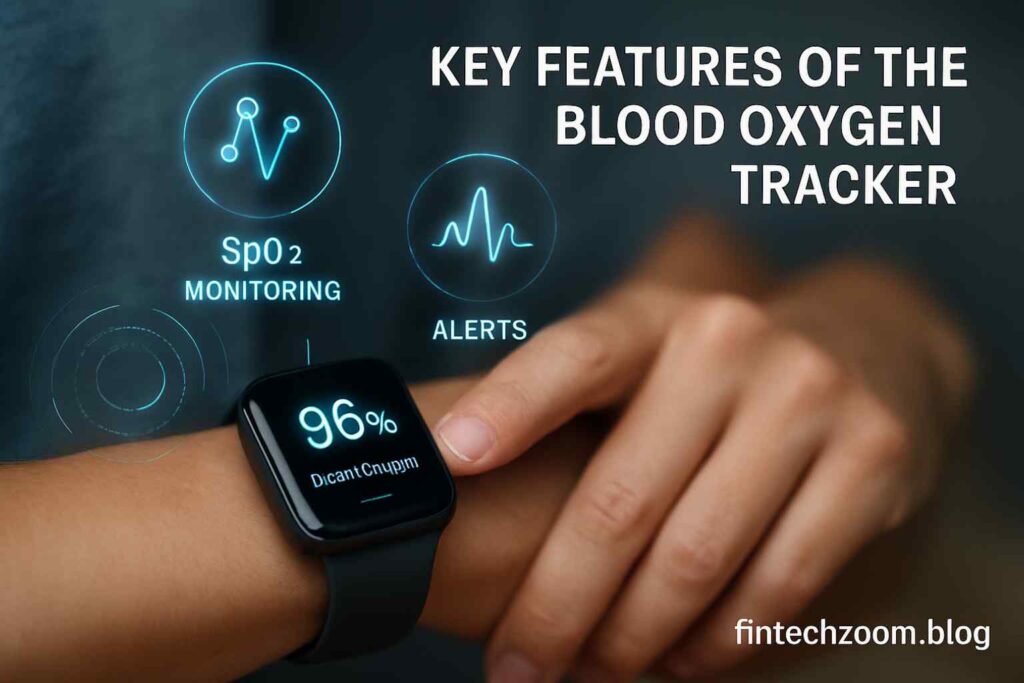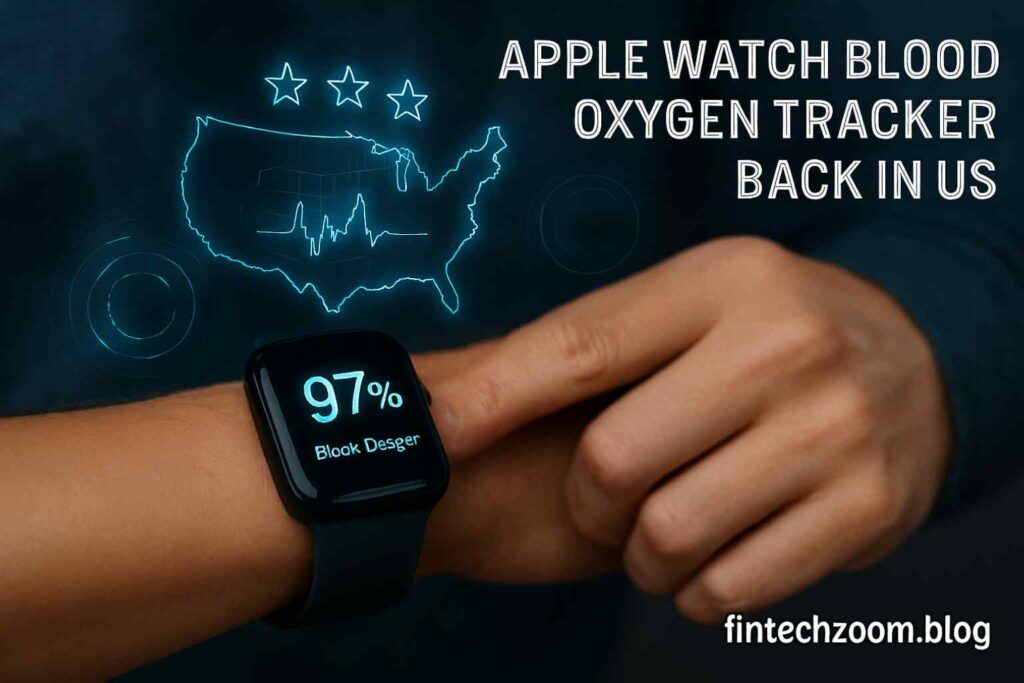Introduction
Apple Watch Blood Oxygen Tracker Back in US marks a major milestone for wearable technology and health monitoring enthusiasts. After being unavailable for some time due to legal and regulatory hurdles, this essential feature has finally returned, giving users in the United States renewed access to one of the most advanced wellness tools in the smartwatch market. Many Apple Watch users rely on the blood oxygen tracker not only for fitness goals but also as an indicator of overall health and well-being, making its comeback both exciting and reassuring. With this reintroduction, Apple has once again demonstrated its commitment to merging innovation with healthcare, offering users the ability to monitor their oxygen saturation conveniently from their wrist.

Why the Blood Oxygen Tracker Matters
The blood oxygen tracker is more than just a fancy addition to the Apple Watch. It plays a crucial role in monitoring your overall health by providing real-time oxygen saturation levels. This feature became especially important during the pandemic when oxygen monitoring was often recommended by medical professionals. With its reintroduction in the US, users can once again rely on Apple’s advanced technology to keep an eye on vital health indicators.
For athletes and active individuals, the tracker is an invaluable tool. Whether you are hiking in high altitudes, running long distances, or practicing yoga, monitoring oxygen levels ensures that your body is performing at its best. Even beyond fitness, everyday users can benefit from early alerts that signal potential breathing or circulation issues, making the Apple Watch more than just a gadget—it becomes a true health companion.
The Road Back to the US Market
Apple faced regulatory challenges in bringing the blood oxygen tracker back to the US market, which temporarily limited its availability. Now, after compliance adjustments and improvements, the feature is once again accessible to American users. This comeback is a win for both Apple and its community, as it ensures that users can take advantage of a powerful health monitoring tool that aligns with global healthcare trends.
This also strengthens Apple’s position in the wearables industry, where competition is growing rapidly. Rival brands may offer health features, but the Apple Watch continues to stand out with its seamless integration of hardware, software, and ecosystem. The re-launch of the blood oxygen tracker is proof that Apple listens to its customers and adapts quickly to meet expectations.

Key Features of the Blood Oxygen Tracker
The Apple Watch blood oxygen tracker works by shining red and infrared light through the skin to measure oxygen levels in the blood. This data is processed using advanced algorithms that provide accurate readings on the watch’s display. What makes it unique is not just the technology, but the way it integrates with the Apple Health app, allowing users to store, track, and analyze their oxygen levels over time.
Here’s a quick look at how the feature compares across recent Apple Watch models:
| Feature | Apple Watch Series 6 | Apple Watch Series 7 | Apple Watch Series 8 | Apple Watch Ultra |
|---|---|---|---|---|
| Blood Oxygen Tracking | ✅ Available | ✅ Improved Accuracy | ✅ Enhanced Sensors | ✅ Advanced Readings |
| Health App Integration | ✅ Yes | ✅ Yes | ✅ Yes | ✅ Yes |
| Battery Life (with usage) | Up to 18 hours | Up to 18 hours | Up to 18 hours | Up to 36 hours |
| Target Audience | General Users | Fitness Enthusiasts | Everyday + Health Focused | Athletes & Adventurers |
This table highlights not only the return of the blood oxygen tracker but also how it has evolved across different Apple Watch generations, with each version bringing better precision and user experience.
How This Impacts Everyday Users
For many people, health features on a smartwatch may seem optional, but the reality is quite different. The blood oxygen tracker provides peace of mind by giving users the ability to detect subtle changes in their body. For example, if oxygen levels drop unexpectedly, the watch can encourage the user to rest or seek medical advice. This preventive approach is what makes the Apple Watch more than a stylish accessory—it becomes a lifesaving device in some cases.
Parents and elderly users also find value in such features. The Apple Watch’s ability to collect and share health data with family or healthcare providers ensures that loved ones are always informed about important health metrics. In a society where proactive healthcare is becoming the norm, this feature’s availability in the US comes at the perfect time.
The Role of fintechzoom.blog in Tech Awareness
Websites like fintechzoom.blog play an essential role in educating readers about the latest updates in technology and wearables. By covering topics such as the Apple Watch blood oxygen tracker, fintechzoom.blog helps users understand how these tools can impact their daily lives. In a fast-paced digital world, staying informed is critical, and fintechzoom.blog ensures that its readers always have access to reliable and practical insights.

Looking Ahead for Apple Watch Users
The reintroduction of the blood oxygen tracker in the US sets the stage for even more advanced health features in future Apple Watch models. Apple’s continuous innovation suggests that users can expect new integrations, potentially including blood glucose monitoring and enhanced heart health features. With each update, the Apple Watch becomes more aligned with the future of personal healthcare, where technology and wellness go hand in hand.
For now, the excitement around the tracker’s return is a strong reminder of how much users value health-focused innovation. Whether you’re an athlete, a busy professional, or someone who simply cares about their well-being, the Apple Watch once again proves itself as a must-have device.
Conclusion
Apple Watch Blood Oxygen Tracker Back in US reflects a significant step forward in the evolution of wearable health technology. The return of this feature is more than just a technical upgrade; it represents a renewed opportunity for users to take control of their wellness with accurate, real-time insights. Apple’s continuous effort to blend lifestyle, health, and innovation has created a device that is not only stylish but also a powerful personal health assistant. As the feature becomes accessible once again, Apple Watch owners can look forward to improved monitoring, better peace of mind, and a future where technology plays an even stronger role in proactive healthcare.
FAQ About Apple Watch Blood Oxygen Tracker Back in US
Q1: Is Apple Watch blood oxygen available in the USA?
Ans: Yes, the Apple Watch blood oxygen feature is now available again in the USA after regulatory clearance, allowing users to track wellness and monitor oxygen levels seamlessly.
Q2: Will the Apple Watch get the oxygen sensor back?
Ans: Yes, Apple Watch models will continue to have the oxygen sensor as the feature has returned in the US market, ensuring health tracking remains complete and reliable.
Q3: Why did the US Apple Watch ban the blood oxygen feature?
Ans: The US ban happened due to a patent dispute over medical technology, and Apple temporarily disabled the feature until a legal settlement allowed its return.
Q4: Why did Apple Watch remove the blood oxygen sensor?
Ans: Apple did not remove the physical sensor but disabled the feature in the US due to legal issues, and it is now re-enabled following regulatory resolution.
Q5: Is Apple Watch blood oxygen available in the USA?
Ans: Yes, Apple Watch users in the USA can now access the blood oxygen feature again after legal restrictions were lifted, restoring full health monitoring.
Q6: Will the blood oxygen feature come back to the Apple Watch?
Ans: Yes, the blood oxygen feature has already come back in the USA, meaning Apple Watch users can once again enjoy accurate oxygen level tracking.
Q7: Why did the US Apple Watch ban the blood oxygen feature?
Ans: The US ban was tied to patent rights over pulse oximeter technology, forcing Apple to disable the feature temporarily until the dispute was resolved.
Q8: Why doesn’t my Apple Watch show blood oxygen?
Ans: Your Apple Watch may not show blood oxygen if the feature is disabled due to regional restrictions, outdated software, or if health settings are not configured properly.

